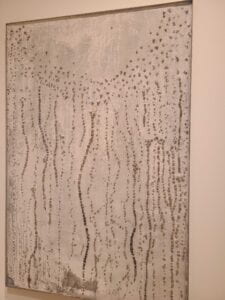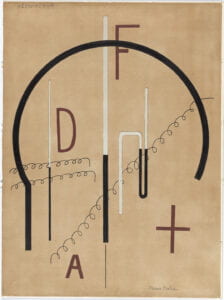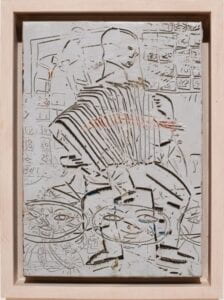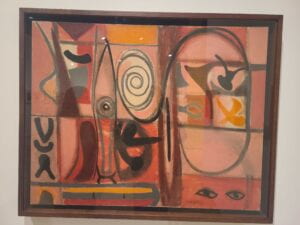Grey Touch Objects Weekly Update
On this page
- Update 1: Project Goals
- Update 2: Competitive Analysis
- Update 3
- Update 4
- Update 5
- Update 6
- Update 7
- Update 8
- Update 9
- Update 10
Weekly Update 10: 4/25/23
As a follow-up, we had a meeting with Leah about the sensory objects remaining on display at the gallery till the end of the current exhibition. We received some helpful feedback about room for improvement in the final prototypes.
Troubleshooting – one of the QR codes was not working because they need subscriptions to be maintained. We decided to shift to free services and host the soundscapes on our project website.
We are now finalizing our presentation with all the user test results from the event on April 15th. We plan to collect some more feedback on the soundscapes and visit the gallery one more time for observing the visitors’ interactions with the sensory objects.
Weekly Update 9: 4/18/23
The event Weekend at the Square on April 15, 2023, was the perfect platform for starting our user tests. The updated versions of our prototypes were displayed in the gallery for visitors to experience. By keeping the accessibility needs of certain visitors in mind, we set up a website for relaying necessary information about this multisensory experience project – Click here to see the page. The website has:
- Information about each of the artworks and the process behind creating the accessible interventions
- The prototypes for the soundscapes in case visitors want to download them and listen through headphones
- A map of where in the gallery the selected artworks can be found with the multisensory objects
- Information about what they need to bring and what to expect
- A feedback form for visitors to leave suggestions on how to improve our project
We also printed leaflets with this information for visitors to pick up from the front desk, which also has all this information from the website about the project and the works, the map, and the QR codes for the soundscapes.
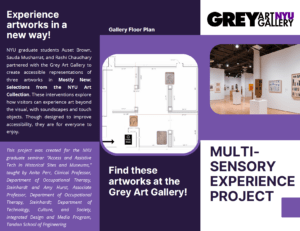
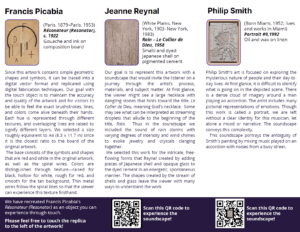
On the day of the event, we interacted with a few visitors at the gallery as they experienced these artworks. We are planning on continuing to collect feedback with a feedback form provided with the leaflet as long as these objects remain on display at the gallery.
Weekly Update 8: 4/11/23
We met with Leah on 04/7 to discuss her feedback on the prototypes we completed. In general, we decided that the audio soundscapes should be longer and include the artist’s process for making the artwork. There is an event happening at the Grey Gallery this weekend that will allow us to get valuable feedback on our work so we are working on the following before Friday:
- For Jeanne Reynal, we will improve the soundscape by playing with the frequency of the rain based on how the spacing of the shells are and the way they are lined then having the chimes cut in and out at certain points of the audio.
- For Philip Smith, we will improve by created more abstraction with weird sounds in the soundscape and playing with the placement of different sounds so it is clear that the work is an abstract work and not a definite.
- Leaflet and Stickers: The goal is to have everything ready by Thursday or Friday next week since there is an event happening at the gallery where we will be able to get the most feedback from guests and students at NYU. First draft of the leaflet is to be review as soon as possible so Leah can be sure that language is representative of the Grey art gallery and it’s aesthetic.
- Website Page: We are going to have a website page that guests can be linked to so they can read up on our process and the descriptions of our work. Click here to see the page.
- Stickers: QR stickers will be added to each of the artworks that include a soundscape so guests can listen on their own devices.
- Comprehensive proposal of items will include a very detailed list of everything that will be in the gallery including measurements , the text we are including, final iterations of the work, descriptions of the work, etc. Michelle Yong (director) and other stakeholders will need to see and approve this so we can move forward with having everything ready for the event during the upcoming weekend.
Link to download the laser files for the touch object of Francis Picabia’s Resonator: click here to access the drive folder
Weekly Update 7: 4/4/23
In the past week, we continued developing our prototypes and gathering feedback from our survey form. We’ve added our survey form to various slack channel and groups to collect as much as possible. We will be meeting with Leah later on this week to discuss the next steps to having our work included in the Gallery.
Weekly Update 6: 3/28/23
After meeting with our mentor, Leah Sweet and the Director of Grey Art Gallery, Michelle Wong, we moved forward with creating the first prototype for the selected artworks. We’ve incorporated these prototypes into our midterm presentation for this week to collect opinions and feedback on any further improvements using a feedback form. With the information we receive back from participants, we will go into the next prototyping stage for the final round of testing. Moving forward, we will also be working on the touch object for the Reynal and the Picabia artwork. The Reynal touch object will include similar materials used in the work on a small 3 by 4 in canvas so visitors can experience how the artwork feels. The Picabia will first be created through vector forms and then laser cut with acrylic.
| John Smith Soundscape – Prototype 1
|
| Jeanne Reynal Soundscape – Prototype 1 |
Weekly Update 5: 3/21/23
While meeting with Leah on March 8th, we discussed our proposal which included the process for how we be creating each artwork. After listening to Leah’s feedback, we made the necessary changes to the proposal and moved forward with setting up an in-person meeting with the director of Grey Art Gallery, Michele Wong. As we walked through the museum space, we were able to see and make changes to our process for how we would present our tactile pieces due to the limited space in front and beside the pieces. We also intended to add some language online about our intervention pieces so visitors are aware and able to do their research before coming. Our final selection includes the artworks below:
|
Jeanne Reynal: Rain
|
Auditory: We would be focusing on the rain and goddess aspect of this artwork that was intended by the artist with sounds of rain falling and the clanging of crystals.
Audio materials:The option is to provide a QR code that will have the sound play from each individual’s mobile device. |
|
Francis Picabia
|
Tactile graphic: This image can be represented through swell form or raised line printing as well. The colors can be differentiated by adding texture to the different elements. While the layering of the overlapping elements would not be as apparent, this format is the most commonly recognized accessible tactile graphic. |
|
Philip Smith
|
Auditory: Instead of representing the actual physical art, we focus on the sounds represented through the art. The idea is to describe the scene in the art by mixing sounds of accordion with busy street noises to portray what the actual scene would have been like.
https://www.youtube.com/watch?v=j33GBVVSjb8 an example of how it may sound like. Audio materials: The option is to provide a QR code that will have the sound play from each individual’s mobile device. |
Weekly Update 4: 3/7/23
Following our discussion with Amy in the last class (Feb 28), we decided to scale back and simplify our ideas in order to ensure we complete the deliverables within our semester timeline. We took into account various evaluation metrics that need to be completed to ascertain how accessible the touch objects we created are. We drafted our proposal (click here to access the document) after researching the many ways we can create accessible representations and will be following up on formalizing this with our mentor in our next meeting on March 8th.
Weekly Update 3: 2/28/23
On February 22nd, we had our 2nd meeting with our mentor where we discussed the next steps. We suggested sending an official proposal to the gallery management on creating touch object representations for some works we selected would be best suited for this project. Our mentor gave us some helpful guides in narrowing down our selection based on the logistics and practicalities of the artwork and how the touch objects would best complement them. More detailed documentation of the meeting can be found here: click on this link to open up the doc file
Following these instructions, we have been drafting a proposal where the selected works and methods of representation are outlined. The reasons for choosing these works are based on:
- Duration of display in exhibit: as part of their permanent collection, these artworks have a better chance of staying on display rather than in storage. Some initial artworks we chose were made of paper which would spend more time in maintenance for which we did not proceed with them.
- Description vs. touch: these artworks lean more towards the abstract which benefits more from a touch or sensory representation than visual description.
- Popularity and importance to the gallery: during our in-person tour, we observed the emphasis on these artworks, their significance to the Grey gallery, and the reaction from the other visitors.
These are the artworks we are proposing to work on:
|
Jeanne Reynal: Rain
Touch object to be created with flowing beads in the form of a necklace with an audio element to add a soundscape of rainfall and twinkling of jewelry |
Philip Smith
Touch object with visual description: The main materials used here would be modeling clay and a carving knife. Along with that an Arduino microcontroller, motion sensor, and a mini speaker.
|
| Adolph Gottlieb
Touch object with sensory elements: This representation would be done with hard slime/modeling clay for organic flesh structure, wires for grids, spirals, and details. There will be a heating element underneath to represent warm colors |
Francis Picabia
Tactile graphic with swell form in different layers. There could also be an audio element to this to produce an electrical buzzing noise
|
Weekly Update 2: 2/21/23
On February 15th, we met with our mentor in person and did a tour of the gallery space. During this tour, we were able to get an idea of some of the most popular and important pieces. We took some time to analyze each work that we had an interest in and decided which approach would be best to produce the optimal outcome. During this visit, we chose 6-7 works that we felt would be beneficial to reproduce.
The following observations are what we are considering to be our initial challenges:
- The gallery will be moving to a new space so we have to create pieces that should be sustainable with this plan. We should not focus on designing with the aesthetics of the current space in mind.
- Creating extra objects, such as a 3D model as an addition to a sculpture, for example, will only be useful if the piece is currently in the exhibit. If it goes to storage, the replica will also take up additional storage space. So we have to design much fewer exact replicas than we initially thought.
- Since there are more paintings and framed pictures than sculptures, we have to find more creative ways to represent them in pursuit of making the gallery experience more accessible
On February 16th, we met with the visual descriptions group to discuss how we might be able to align on this project. During this meeting, we exchanged ideas on the works that were of interest and how we can collaborate on some of the pieces.
We agreed that within the spectrum of real to abstract, the visual descriptions would be helpful towards the more realistic visuals while the abstract would benefit from other forms of representation. There are some art pieces that fall within the intersection of these two categories which we are considering collaborating on. We will also verify our choices with the TouchTree team, and test out the touch object decision tree in creating our first proposal.

Our first proposal consists of listing all the artwork we have selected from our tour of the gallery which we have an idea of how to represent as touch objects. We will be running this by our mentor and based on her feedback, start finalizing the list of artwork and how to best recreate them.
Weekly Update 1: 2/14/23
GROUP INFORMATION
Group Members: Sauda Musharrat*, Auset Brown, Rashi Chaudhary
Project Mentor(s): Leah Sweet – Head of Education and Programs
Meeting times: Mondays at 11:30 am
* Point of Contact
PROJECT DESCRIPTION
For this project, we will be identifying specific artifacts within the the Grey Art Gallery and creating touch objects/replicas of them. Sensory objects can be made with various materials to create a valuable sensory experience for those who have visual impairments, differing cognitive capabilities, or those who’d like to experience the artifact in a new way. We will be utilizing 3-d modeling skills, embroidery, tactile image, and an assemblage of other materials to create our replicas. Our group will be meeting weekly to provide updates and explore the most useful ways to ensure a exciting and unique interaction.
The goal of this project is to collaborate with the Grey Art Gallery to make the visitor experience more accessible than it currently is. By iterating through possible ideas on how to best represent their permanent collection of artwork, we would explore various means of representation not limited to only touch. This includes embodied or sensory experiences, tactile graphics, audio, and even interactive forms of conveying the key art pieces of the gallery. All of these additions will also have to fit in with the aesthetic considerations of the gallery space and remain sustainable over long-term exhibition plans.
TEAM NAME
The name for this project is ModTech. This name was created from the words “Model” and “Technology”. During this project we will be using various techniques to create replicas currently at the Grey Art Gallery. ModTech as a name is unique and gives a very direct but subtle idea of the work we will be making during this project.
GOAL FOR THIS PROJECT
Our team will be attending a guided tour at the Grey Art Gallery tomorrow (02/15/2023) to view the overall space and decide which artworks will be replicated for this project. In addition to this, we will be meeting with the director of the gallery to make sure we are on the same page with aesthetics and safety considerations. The goal will be to create successful replicas of the artworks that create an interactive, and intriguing experience.
Our goal is to spend the first couple weeks planning and designing how we’d like to incorporate the replica into the gallery space as well as getting familiar with the various techniques used to replicate the works.
TEAM MEMBER RESPONSIBILITIES
- Research various examples of tactile images, 3-d models, etc. used in museums
- Visit museums with touch objects incorporated into their galleries
- Create multiple designs for replicas and make a proposal for our mentor
- Reach out to the gallery director and other stakeholders to come to a consensus on how and where the replicas should be placed in the museum
- Review the technique for each of the artworks and utilize the Makerspace on campus
- Record progress and test the effectiveness of the replica.
